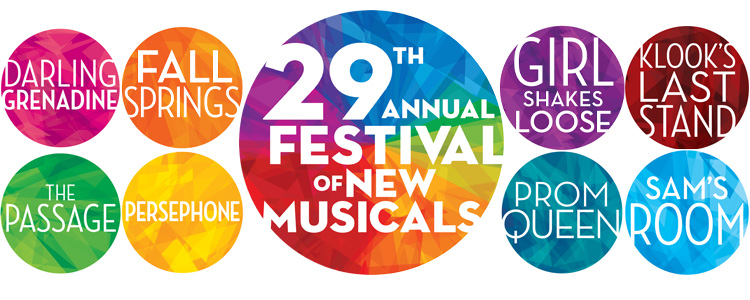1. GIRL Shakes Loose features some of the poetry of legendary writer, activist and former poet laureate of Philadelphia Sonia Sanchez; in fact the title of the musical is a play on the Sanchez collection of poetry, ‘Shake Loose My Skin.’ In the musical, her poetry is used as song, often giving voice to the characters’ interior feelings.
2. The musical features “direct address” where the protagonist, GIRL, at times speaks directly to the audience, breaking the theatrical fourth wall and allowing a more stylized approach to storytelling.
3. The music from this show contains a wide range of styles including: choral, blues, R&B, funk, rock, house and classic musical theater to show the different soundscapes for each city GIRL travels to, as well as the diversity that she has grown up with.
4. This musical utilizes a Chorus with those characters playing a multitude of roles in our protagonists’ life—in fact everyone is a part of this Chorus except the lead; they are all in support of her journey. Musically, the Chorus provides aspects of narration, harmonies, call and response, polyrhythms and intertwined melodies.
5. Our title character is named GIRL because in many ways this is a universal girl who is trying to come of age, and we so rarely see women of color cast as the lead in universal roles in American theater.
Five Things You Should Know About Klook’s Last Stand
Book by Ché Walker, Music by Omar Lyefook & Anoushka Lucas, Lyrics by Ché Walker & Anoushka Lucas
1. Klook’s Last Stand came out of Ché Walker’s work teaching creative writing and acting in men’s prisons, young offender institutions, and ex-offender support projects—work he has done for over twenty years. The team was keen to try and break through some stereotypes about ex-offenders and challenges faced by working-class people the world over.
2. Ché Walker, Anoushka Lucas and Omar Lyefook conceived Klook’s Last Stand as one long, uninterrupted song, rather than a conventional musical. Some songs are exactly one line long and some speeches are underscored. The writers were interested in synthesizing speech and song and trying to make something different.
3. The duets are collaborations between Omar and Anoushka; Klook’s songs are composed by Omar and Vinette’s songs are composed by Anoushka. The idea was that each character has a distinct sensibility and voice.
4. The script has a blend of direct address and short scenes—the team wants to pull the audience to them and strip away all unnecessary effects and distractions.
5. The team is based in the UK, but all three writers grew up hugely influenced by American Literature and Music—and they love New York!
Five Things You Should Know About The Passage
By David Darrow
1. The Passage is autobiographical. It is based on the author’s experience living in a house with a sick family member. The house in The Passage functions almost as another character.
2. For a musical, it is small and very intimate. There are scenes that take place in tiny areas—a tent, a closet, a bathroom—but the world should feel enormous to Albert, and his journey into the basement should feel epic.
3. The main characters don’t sing. There is a chorus of four actors who play various parts of the world—a dog, a box of memories, a pile of coats—and they supply the music of the world. The chorus in many ways represents the inner life of the characters.
4. Although the two leads, Albert and Cassie, are children, The Passage is not a piece of children’s theater.
5. This piece had its first workshop and production at The Guthrie Theater in Minneapolis, where it was developed and produced by 7th House Theater. I am looking for partners to help with the next stages—further development and a larger production.

Five Things You Should Know About Persephone
Book & Lyrics by Marcus Stevens, Music by Oran Eldor
1. You do not need to be an expert on Greek mythology to enjoy Persephone. The characters are universal, and the story has been reimagined to tell a decidedly modern tale about how we find our true selves and our own place in the world.
2. Persephone blends the contemporary world with an ancient, mythical one. Its anachronistic quality is intended to inspire inventive staging and design.
3. The show’s music is inspired by a range of contemporary pop, rock and R&B. Each principal in the show evokes their own unique brand of pop-star—the Gods are celebrities, after all!
4. The cast should be a diverse group of actors who represent our modern world. There is creative flexibility with the size of the ensemble and the doubling of supporting roles.
5. Our ultimate goal is to find a home for Persephone in New York. Through our participation in the NAMT Festival of New Musicals, we are hoping to find the right regional theater(s) to partner with for the World Premiere production.

Five Things You Should Know About Prom Queen
Book by Kent Staines, Lyrics by Akiva Romer-Segal, Music by Colleen Dauncey
1. Prom Queen is based on the true story of Marc Hall, who took the Durham Catholic District School Board to court in 2002. The precedent-setting case sparked an international media storm, making the blue-haired teen the face of a new generation fighting for equality. Marc became the subject of countless news stories, a documentary and the beloved Canadian TV movie Prom Queen: The Marc Hall Story produced by Mary Young Leckie and written by Kent Staines, both of whom continue in their respective roles (producer, book writer) for this musical adaptation.
2. Songwriting team Colleen Dauncey and Akiva Romer-Segal first met in high school, around the same time the story takes place. They mined many of their musical influences from this era, which infused the score with early 2000 pop, dance, R&B, country, gospel and more.
3. Prom Queen began its development process at Sheridan College’s Canadian Music Theatre Project (CMTP) in Oakville, Ontario. This amazing incubation program provided first steps for hit Canadian musicals Come From Away and Theory of Relativity.
4. In 2016 Prom Queen made its regional debut at the Segal Centre for Performing Arts in Montreal where the run was so successful with audiences of all ages that it was extended. The musical was awarded the prestigious Pechet Family Prize for Best New Musical by the Playwrights Guild of Canada.
5. We are looking to establish new relationships with theaters and producers as we hone our show and work towards our ultimate goal of regional and commercial productions.
 Five Things You Should Know About Sam’s Room
Five Things You Should Know About Sam’s Room
Book by Dale Sampson with Trey Coates-Mitchell, Music & Lyrics by Caitlin Marie Bell, Marc Campbell, & Dale Sampson
1. Sam is a teenager with nonverbal and physical special needs. The research and exploration into this sensitive and compelling subject never ends. The team is committed to ongoing growth and discovery through field research in augmentative alternative communication and by working with teachers, families and experts in the field in order to spread awareness and strengthen the case for the importance of continued conversation on the subject of specials needs education.
2. The year is 1998. A JVC boombox blasts Backstreet Boys, and a Total Request Live VJ introduces the hot new boyband, N’SYNC. Debate over Bill Clinton’s sexual improprieties on the six o’clock news kills time before Home Improvement and Ally McBeal. In public schools, the day begins with Channel One News and ends with PTA discussions concerning IDEA and their efforts to provide public education opportunities for students with disabilities.
3. While in the comfort of his bedroom, Sam uses his imagination to transform himself into international superstar and ultimate communicator, Sammy Star. He transforms his bedroom into a concert stadium and takes the audience on a journey through a variety of musical genres. In this imaginary world, Sam achieves something that seems impossible in his current reality; communicating to thousands of people through his own unique songs and lyrics. Through music, he constructs a place inside his mind where he can be entirely himself and express everything he wants to say.
4. To help separate Sam’s nonverbal reality from his superstar fantasy, we use an original style of staging inspired by the National Speech and Debate Association, the oldest and largest speech and debate honor society in the world. These techniques help the cast of 3 innovatively create storytelling magic with nothing but their voices and bodies rather than using sets, costumes, props, etc.
5. Sam’s Room explores the human condition, exposing the difficulties of communication with one another. In a world where we can instantly speak our minds with the click of a button, we seem to suffer a mass disability when expressing feelings and ideas in a healthy productive manner. Sam’s journey to communicate explores the true power of the human voice.







 Five Things You Should Know About Sam’s Room
Five Things You Should Know About Sam’s Room

